
Eugène Henri Paul Gauguin was a French Post-Impressionist artist. Unappreciated until after his death, Gauguin is now recognized for his experimental use of colour and Synthetist style that were distinct from Impressionism. Toward the end of his life, he spent ten years in French Polynesia. The paintings from this time depict people or landscapes from that region.
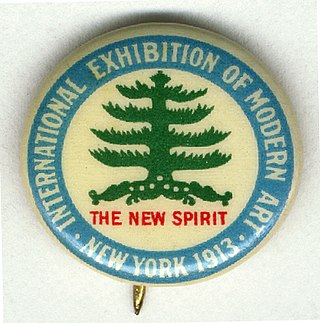
The 1913 Armory Show, also known as the International Exhibition of Modern Art, was organized by the Association of American Painters and Sculptors. It was the first large exhibition of modern art in America, as well as one of the many exhibitions that have been held in the vast spaces of U.S. National Guard armories.
Tahitian is a Polynesian language, spoken mainly on the Society Islands in French Polynesia. It belongs to the Eastern Polynesian group.

Where Do We Come From? What Are We? Where Are We Going? is a 1897–98 painting by French artist Paul Gauguin. The painting was created in Tahiti, and is in the Museum of Fine Arts in Boston, Massachusetts. Viewed as a masterpiece by Gauguin, the painting is considered "a philosophical work comparable to the themes of the Gospels".

Les Demoiselles d'Avignon is a large oil painting created in 1907 by the Spanish artist Pablo Picasso. Part of the permanent collection of the Museum of Modern Art in New York, it portrays five nude female prostitutes in a brothel on Carrer d'Avinyó, a street in Barcelona, Spain. The figures are confrontational and not conventionally feminine, being rendered with angular and disjointed body shapes, some to a menacing degree. The far left figure exhibits facial features and dress of Egyptian or southern Asian style. The two adjacent figures are in an Iberian style of Picasso's Spain, while the two on the right have African mask-like features. Picasso said the ethnic primitivism evoked in these masks moved him to "liberate an utterly original artistic style of compelling, even savage force” leading him to add a shamanistic aspect to his project.
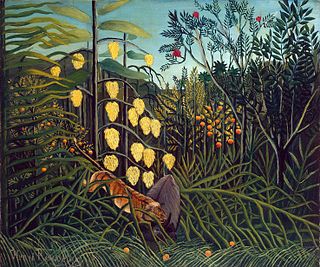
In the arts of the Western World, Primitivism is a mode of aesthetic idealization that means to recreate the experience of the primitive time, place, and person, either by emulation or by re-creation. In Western philosophy, Primitivism proposes that the people of a primitive society possess a morality and an ethics that are superior to the urban value system of civilized people.

Tahitian Women on the Beach is an oil painting by the French artist Paul Gauguin. Depicting two Tahitian women, this piece is one of a series of works completed by Gauguin during his first stay on the Pacific island chain. Enamored by the environment and people of the islands and their separation from European cultural and aesthetic attitudes, Gauguin portrays two figures shrouded in the mystery and symbolism of Tahiti’s paradise.

Oviri is an 1894 ceramic sculpture by the French artist Paul Gauguin. In Tahitian mythology, Oviri was the goddess of mourning and is shown with long pale hair and wild eyes, smothering a wolf with her feet while clutching a cub in her arms. Art historians have presented multiple interpretations—usually that Gauguin intended it as an epithet to reinforce his self-image as a "civilised savage". Tahitian goddesses of her era had passed from folk memory by 1894, yet Gauguin romanticises the island's past as he reaches towards more ancient sources, including an Assyrian relief of a "master of animals" type, and Majapahit mummies. Other possible influences include preserved skulls from the Marquesas Islands, figures found at Borobudur, and a 9th-century Mahayana Buddhist temple in central Java.

Lizzie Plummer Bliss, known as Lillie P. Bliss, was an American art collector and patron. At the beginning of the 20th century, she was one of the leading collectors of modern art in New York. One of the lenders to the landmark Armory Show in 1913, she also contributed to other exhibitions concerned with raising public awareness of modern art. In 1929, she played an essential role in the founding of the Museum of Modern Art. After her death, 150 works of art from her collection served as a foundation to the museum and formed the basis of the in-house collection. These included works by artists such as Paul Cézanne, Georges Seurat, Paul Gauguin, Henri Matisse, Pablo Picasso and Amedeo Modigliani.
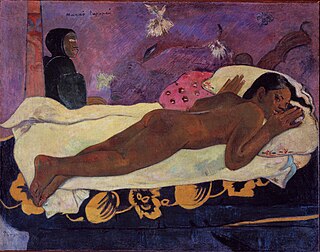
Spirit of the Dead Watching (Manao tupapau) is an 1892 oil on burlap canvas painting by Paul Gauguin, depicting a nude Tahitian girl lying on her stomach. An old woman is seated behind her. Gauguin said the title may refer to either the girl imagining the ghost, or the ghost imagining her.

When Will You Marry? is an oil painting from 1892 by the French Post-Impressionist artist Paul Gauguin. On loan to the Kunstmuseum in Basel, Switzerland for nearly a half-century, it was sold privately by the family of Rudolf Staechelin to Sheikha Al-Mayassa bint Hamad Al-Thani, in February 2015 for close to US$210 million, one of the highest prices ever paid for a work of art. The painting was on exhibition at the Fondation Beyeler, Riehen, until 28 June 2015.

Fatata te Miti is an 1892 oil painting by French artist Paul Gauguin, located in the National Gallery of Art, in Washington, DC.

Vahine no te vi is an 1892 painting by Paul Gauguin, currently in the collection of the Baltimore Museum of Art. It is one of the earliest of about seventy paintings he produced during his first visit to Tahiti and is one of many works of modern art in the museum's Cone Collection.

Merahi metua no Tehamana is an 1893 painting by the French artist Paul Gauguin, currently in the collection of the Art Institute of Chicago. The painting is a portrait of Paul Gauguin's wife Teha'amana during his first visit to Tahiti in 1891–1893. This marriage has always provoked controversy because it was arranged and completed in the course of a single afternoon and Gauguin claimed Teha'amana was just thirteen years old at the time.
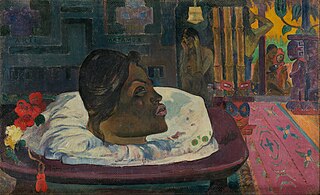
Arii Matamoe or The Royal End is a painting on coarse cloth by the French artist Paul Gauguin, created in 1892 during the painter's first visit to Tahiti. It depicts a man's severed head on a pillow, displayed before mourners, and although it did not depict a common or contemporary Tahitian mourning ritual, may have been inspired by the death of Pōmare V in 1891 shortly after Gauguin's arrival. A curator for the J. Paul Getty Museum suggested Gauguin likely painted the canvas "to shock Parisians" upon his expected return to the city.
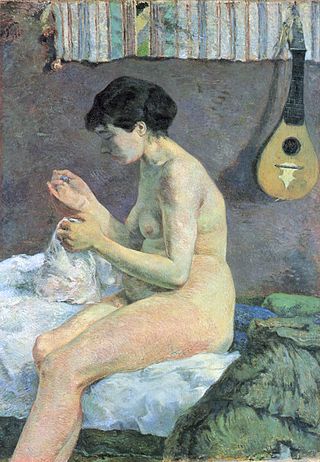
Study of a Nude, or Suzanne sewing is an 1880 painting made by Paul Gauguin in Paris. It is currently in the collection of the Ny Carlsberg Glyptotek in Copenhagen. The painting depicts a young woman who is arranging a garment in undisguised nakedness.
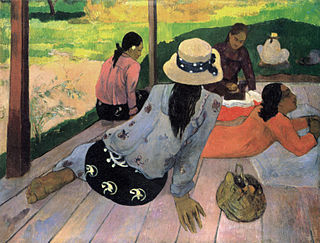
The Siesta is an 1892-1894 oil on canvas painting by Paul Gauguin, now in the Metropolitan Museum of Art in New York. It was painted during Gauguin's first extended trip to the island of Tahiti.

Mahana no atua is an 1894 oil painting by the French Post-Impressionist artist Paul Gauguin which is in the collection of the Art Institute of Chicago.

The Bunch of Flowers or Flowers of France is an oil on canvas painting by Paul Gauguin, from 1891. It is held in the Pushkin Museum in Moscow. It was one of the first in his series of Tahitian works.

Self-Portrait as a Tahitian is an oil painting on canvas created in 1934 by Amrita Sher-Gil, when she was studying in Paris. It is held in the Kiran Nadar Museum of Art, India. Under India's Antiquities and Art Treasures Act (1972) the work is a national art treasure and must stay in India.



















